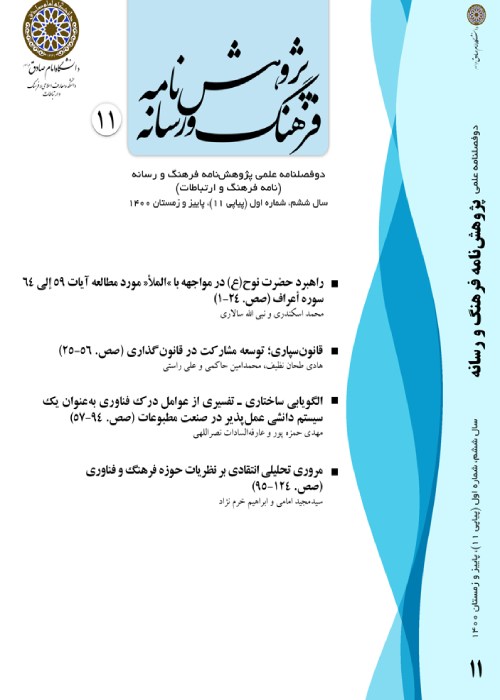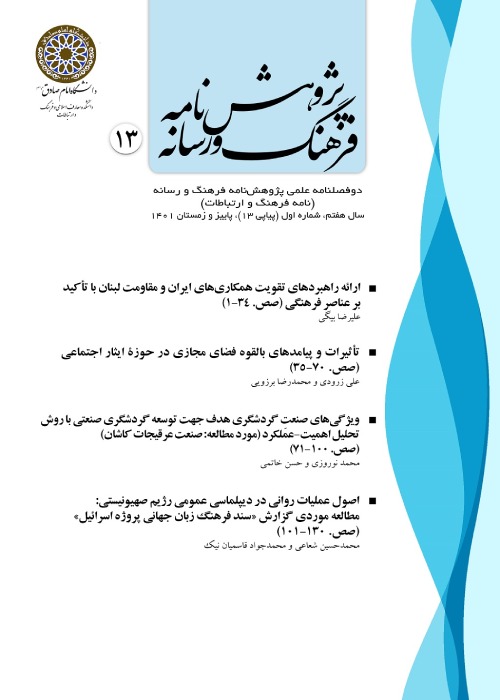فهرست مطالب

پژوهش نامه فرهنگ و رسانه (نامه فرهنگ و ارتباطات)
سال ششم شماره 1 (پیاپی 11، پاییز و زمستان 1400)
- تاریخ انتشار: 1402/10/01
- تعداد عناوین: 4
-
صفحات 1-24
داستان های قرآن کریم، درس های اجتماعی زیادی دارد که مفسران، در تفسیر آیات داستانی قرآن کمتر به این جنبه ها پرداخته اند. پیامبران، رهبران جامعه خودشان هستند، بنابراین شیوه ی دعوت مردم توسط آن ها، مقابله ی آنان با مخالفانشان و... می تواند الگوی خوبی برای رهبران و مردم یک جامعه دینی باشد. این مقاله به دنبال آن است تا علاوه بر توضیح آیات از دیدگاه مفسران، به بیان درس های اجتماعی داستان حضرت نوح در آیات 59 إلی 64 سوره اعراف نیز بپردازد. شیوه ی پاسخ دادن حضرت نوح به جنگ رسانه ای دشمن و تهمتی که «الملا» (خواص) به او می زنند، دلسوزی و روشنگری زیاد برای جلوگیری از گمراهی مردمی که تحت تاثیر تهمت های دشمن، نسبت به جامعه ی دینی بدبین می شوند، از جمله درس هایی است که در این پژوهش به آن اشاره می شود؛ درس هایی که یک جامعه ی دینی مانند جمهوری اسلامی ایران می تواند از آن استفاده کند. روش تحقیق در این پژوهش، توصیفی-تحلیلی و شیوه ی گردآوری اطلاعات، کتابخانه ای و بر اساس منابع مکتوب و الکترونیکی است.
کلیدواژگان: حضرت نوح، درس های اجتماعی، نوح، الملا، سوره اعراف -
صفحات 25-55
مشارکت مردم در حکومت در حال تغییر و تحول است و با پیشرفت جوامع، متکامل می گردد. مشارکت مردمی دارای الگوهای متفاوتی بوده است. الگویی که هم اکنون متداول است، الگوی نمایندگی است. لکن با بروز پدیده ای به نام قانون سپاری، این الگو در معرض تغییرات گسترده واقع شده است. الگوی قانون سپاری مبتنی بر حضور مردم در فرایندهای تصمیم گیری و تصمیم سازی است. قانون سپاری به زیرساخت هایی نظیر شفافیت نیازمند است و در رواج خود، مدیون استفاده از روش های نوآوری باز و جمع سپاری است. قانون سپاری در بستر اینترنت شکل می گیرد. در قانون سپاری می توان مساله یابی و تدوین پیش نویس یک قانون و یا اصلاح آن را به مردم واگذار کرد. به عبارتی، مردم به نحوی دارای صلاحیت ابتکار قانون می شوند. به منظور این که بتوان میزان پیشرفت قانون سپاری در مراحل مختلف قانون گذاری را دانست، باید به ماهیت نمایندگی نظر افکنده، مقایسه ای را سامان داد. لذا مساله ی این پژوهش، مقایسه-ی میان نمایندگی و قانون سپاری است تا بتوان با شناخت مبانی آن، در مجالی دیگر الگوی بومی قانون سپاری را طراحی کرد. بدین منظور، این مطالعه با ترکیبی از روش های «موردکاوی» و «تفسیری» درصدد واضح ساختن افق پیش روی قانون سپاری و چگونگی حضور آن در فرایند قانون گذاری است.در نتیجه، با یافتن فهمی از قانون سپاری می توان آن را بومی سازی کرد. برای داشتن چنین دریافتی، باید از آموزه های اسلامی نظیر شورا و مسیولیت اجتماعی بهره برد. همچنین، بهره گرفتن از قابلیت های بازی وارسازی این پلت فرم ها، کمکی شایان به بومی سازی رویکرد جمع سپارانه در قانون گذاری است.
کلیدواژگان: نمایندگی، جمع سپاری، قانون سپاری، مشارکت، پارلمان -
صفحات 58-93
مفهوم فناوری در حال تغییر از فناوری با زمینه محدود به فناوری با زمینه گسترده و از فناوری سخت به فناوری نرم است؛ حال پژوهش حاضر به دنبال استخراج عناصر اصلی پذیرش فناوری نرم در صنعت مطبوعات به منظور ارایه بستری اطمینان بخش برای استقرار فناوری نرم است. این پژوهش ازنظر هدف کاربردی بنیادی بوده و با رویکرد ترکیبی انجام شد. در بخش کیفی از روش تحلیل مضمون و در بخش کمی از روش ساختاری تفسیری استفاده کرده است. جامعه پژوهش در بخش کیفی خبرگان سازمانی و دانشگاهی صنعت مطبوعات و در بخش کمی مدیران و کارشناسان ارشد حاضر در موسسه مطبوعاتی ایران بودند. در گام اول پژوهش، پس از مصاحبه با 11 نفر از خبرگان و فعالان حوزه رسانه و فناوری و رسیدن به اشباع نظری و تحلیل و بررسی مصاحبه به روش تحلیل مضمون، 105 مضامین پایه و 32 مضامین سازمان دهنده و درنهایت 9 مضمون فراگیر شناسایی شد. در گام دوم پژوهش با استفاده از تکنیک مدل سازی ساختاری_تفسیری توسط 11 نفر از مدیران و کارشناسان حاضر در موسسه مطبوعاتی ایران و تحلیل پرسشنامه ها در نرم افزار MATLAB، موقعیت، میزان اهمیت، اثرگذاری (نفوذ) و اثرپذیری (وابستگی) عناصر استخراج شده در پنج سطح ارایه شد؛ در سطح اول انگیزش و نگرش مثبت نیروی انسانی، سطح دوم تحول گرایی سیستم مدیریت، سطح سوم پویایی ساختار سازمانی، توانمندسازی منابع انسانی و گستردگی شبکه ارتباطات داخلی و خارجی، سطح چهارم رقبا و متغیر بودن محیط، یادگیرنده بودن فرهنگ سازمانی و مشتری محور بودن استراتژی سازمان و درنهایت سطح پنجم ماهیت کاربردی پذیرش فناوری نرم شناسایی شده است.
کلیدواژگان: فناوری نرم، مدل سازی ساختاری تفسیری (ISM)، سیستم دانش، رویکرد آمیخته، صنعت مطبوعات -
صفحات 95-132
فناوری ها جزء جدانشدنی زندگی امروزی ما هستند. زندگی انسان دراین فضا وابسته به تحلیل فرهنگی او از این پدیده است و این تحلیل نیز برخواسته از فهم فرهنگی فناوری. متن حاضر مروری است بر گفتمان ها و نظریات مهم و جریانات تاثیرگذار در این حوزه. نقد و بررسی گفتمان جبرگرایی و تامل در ابعاد آن اولین بخش متن را تشکیل میدهد و با مرور گفتمان برساخت گرایی، نگاه مقابل جبرگرایی را موردبررسی قرار خواهیم داد. سپس از منظر تن زدودگی و تن یافتگی به عنوان انسان شناسی فناوری به شبکه های اجتماعی و فناوری های شبکه ای خواهیم نگریست. پس ازآن نظریه مشهور و میان رشته ای شبکه کنشگران را به عنوان پدیدارشناسی فناوری جدید مطرح نموده و درنهایت نظریات انتقادی فینبرگ را به عنوان نقد فلسفی بر ماهیت فناوری مرور خواهیم کرد.پس از هر فصل سعی شده است از منظر کاربردی و از زاویه نگاه بومی به تامل درباره مطالب مطروحه پرداخته شود.. . . . . .
-
Pages 1-24
The stories of the Holy Qur'an have many social lessons that the commentators have paid less attention to in interpreting the narrative verses of the Qur'an.Prophets are the leaders of their own society, so the way they invite people, their confrontation with their opponents, etc. can be a good example for the leaders and people of a religious community. This article seeks to explain the verses from the perspective of commentators, to express the social lessons of the story of Noah in verses 59-64 of Surah A'raf. Noah's response to the enemy's media warfare and the accusation leveled at him by al-Mulla (properties), great compassion and enlightenment to prevent the misguidance of the people who become pessimistic about the religious community under the influence of the enemy's slander. It is one of the lessons mentioned in this research; Lessons that a religious community like the Islamic Republic of Iran can use. The research method in this research is descriptive-analytical and the method of collecting information is library based on written and electronic sources.
Keywords: Prophet Noah, social lessons, Noah, the world, Surah A'raf -
Pages 25-55
People’s participation in government is changing and it is evolving with progress of societies. People’s participation has different patterns. The pattern that is now commonplace is the representation model. But, this pattern has undergone extensive changes, with the emergence of a phenomenon called CrowdLaw. The pattern of CrowdLaw is based on presence of people in consultation and decision-making process. CrowdLaw has need to some infrastructures like “Transparency” and in the spread, it is due to the use of open innovation and Crowd-Sourced methods. CrowdLaw is taking shape on the Internet. It can delegated to the people, in CrowdLaw, finding the problems and drafting a law and amendment of it. In other words, people have the authority to initiate the law. For estimating how the crowdlaw has improvement in rulemaking, it should be known the nature of representation and establish a comparance. Therefore, the problem of this research is the comparison between representation and CrowdLaw to know its principals to design the native pattern of CrowdLaw in other opportunities. To this end, this study, with a combination of “case study” and “interpretive” methods, seeks to clarify the horizon of CrowdLaw and how it is involved in the legislative process. Finally, it can be localized by understanding the CrowdLaw. To have such an understanding, one must benefit from Islamic teachings such as shura and social responsibility. Also, gaining the gameplay capabilities of these platforms is a great help in localizing the use of the rules collected in the law.
Keywords: Representation, Crowdsourcing, Crowdlaw, participation, Parliament -
Pages 58-93
The concept of technology is changing from technology with limited context to technology with broad context and from hard technology to soft technology. The present study seeks to extract the main elements of soft technology adoption in the press industry in order to provide a reliable platform for the establishment of soft technology. . In the qualitative part, it has used the method of content analysis and in the quantitative part, it has used the structural-interpretive method. The research community was in the qualitative part of the organizational and academic experts of the press industry and in the quantitative part of the managers and senior experts present in the Iranian Press Institute. In the first step of the research, after interviewing 11 experts and activists in the field of media and technology and achieving theoretical saturation and analysis and review of the interview by content analysis, 105 basic themes and 32 organizing themes and finally 9 comprehensive themes were identified. In the second step of the research using structural-interpretive modeling (ISM) technique by 11 managers and experts present in Iran Press Institute and analyzing the questionnaires in MATLAB software, position, importance, effectiveness (influence) ) And the effectiveness (dependence) of the extracted elements were presented at five levels; In the first level, the motivation and positive attitude of human resources, in the second level, the evolution of the management system, in the third level, the dynamics of the organizational structure, human resource empowerment and the expansion of internal and external communication network, The centrality of the organization's strategy and finally the fifth level of the applied nature of the adoption of soft technology has been identified.
Keywords: soft technology, structural-interpretive modeling (ISM), knowledge system, Mixed method, press industry -
Pages 95-132
Technology is an integral part of our lives today. Man’s life in this space depends on his cultural analysis of this phenomenon, and this analysis also arises from the cultural understanding of technology. This phenomenon has been studied and theorized from different philosophical, social and cultural perspectives in the last century. The present text is an overview of important discourses and theories and influential currents in this field. Critique of the discourse of determinism and reflection on its dimensions constitute the first part of the text, and by reviewing the discourse of constructivism, we will examine the opposite view of determinism. We will then look at social networks and network technologies from the perspective of disembodiment and incarnation as the anthropology of technology. We will then present the well-known and interdisciplinary theory of the network of actors as the phenomenology of new technology, and finally review Feinberg’s critical theories as a philosophical critique of the nature of technology.After each chapter, an attempt has been made to reflect on the issues from a practical point of view and from a local point of view.
Keywords: Sociology of technology, technology culture, constructivism, disembodiment, network of actors


